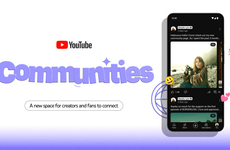
NEXT by Ramla — February 8, 2007 — Pop Culture
References: futureofcommunities & nextbyramla.blogspot
"Communities" ought to be the most significant emerging concept of the Internet world.
Communities 2.0 - the virtual world
The child of social networking sites meeting user-content driven (web 2.0) websites: communities.
Built around common interests, preferences, or themes, communities are virtual spaces that bring together like-minded folks. On social networking sites such as Orkut and user-content driven spaces like Flickr, users can quickly and easily create thematic communities that attract the interested.
Unlike the older days of the Web, these "2.0" (new Web) communities are self-regulating and flexible. Rules are minimal, and members are encouraged to familiarize themselves with them, and regulate their own behavior. Individuals moderate or own the communities; the success of their "leadership" depends directly upon their abilities and acceptance by the members. A badly regulated, dismal communities dies by attracting no members, who are free to "settle" into another space or create their own. Good leadership - determined by the leader's tolerance, inclusiveness, conflict resolution, and community marketing skills - leads to healthy, growing communities that attract both members and participation. Charisma works.
Communities are small localities and nations in their own right. This is why I suggest that the Internet is the blueprint for a truly human(e) government.
Because of their open nature and inclusiveness of opinion, communities offer real insights into social life. Thanks to technology, they are fast-paced, ever-evolving, and allow for quick spread of info. Communities also change their form quickly to suit a campaign or project.
This is why, truly savvy change leaders and marketers are taking note of the phenomenon. The Future of Communities is a blog branched out from the upcoming Community 2.0 Conference. It's all about communities and their growing power in the new world of Internet.
Communities 2.0 - the virtual world
The child of social networking sites meeting user-content driven (web 2.0) websites: communities.
Built around common interests, preferences, or themes, communities are virtual spaces that bring together like-minded folks. On social networking sites such as Orkut and user-content driven spaces like Flickr, users can quickly and easily create thematic communities that attract the interested.
Unlike the older days of the Web, these "2.0" (new Web) communities are self-regulating and flexible. Rules are minimal, and members are encouraged to familiarize themselves with them, and regulate their own behavior. Individuals moderate or own the communities; the success of their "leadership" depends directly upon their abilities and acceptance by the members. A badly regulated, dismal communities dies by attracting no members, who are free to "settle" into another space or create their own. Good leadership - determined by the leader's tolerance, inclusiveness, conflict resolution, and community marketing skills - leads to healthy, growing communities that attract both members and participation. Charisma works.
Communities are small localities and nations in their own right. This is why I suggest that the Internet is the blueprint for a truly human(e) government.
Because of their open nature and inclusiveness of opinion, communities offer real insights into social life. Thanks to technology, they are fast-paced, ever-evolving, and allow for quick spread of info. Communities also change their form quickly to suit a campaign or project.
This is why, truly savvy change leaders and marketers are taking note of the phenomenon. The Future of Communities is a blog branched out from the upcoming Community 2.0 Conference. It's all about communities and their growing power in the new world of Internet.
Trend Themes
1. Virtual Communities - There is an increasing trend towards the creation of virtual communities that are built around common interests, preferences, or themes with minimal rules and flexible governance.
2. Self-regulating Communities - Communities with self-regulating and flexible governance structures are increasingly popular, as they allow members to regulate their own behavior and promote inclusiveness of opinion.
3. Communities as Small Localities - Communities are increasingly being recognized as small localities and nations in their own right, providing real insights into social life and enabling quick spread of info while changing their form quickly to suit a campaign or project.
Industry Implications
1. Social Media - Social media companies can continue to innovate by developing user-content driven spaces and virtual communities with flexible governance structures built around common interests or themes.
2. Marketing - Marketers can tap into the growing power of virtual communities to promote their campaigns, products and services through engagement with self-regulating and tolerant community leaders who possess community marketing skills.
3. Governance - Governments can learn from the open nature and inclusiveness of opinion to design and implement better, more human(e) governance structures that reflect the self-regulating and flexible governance structures of virtual communities.
1.9
Score
Popularity
Activity
Freshness























